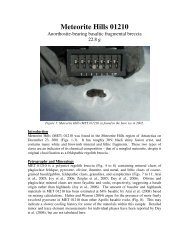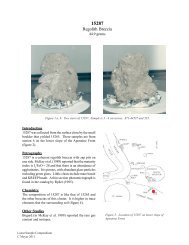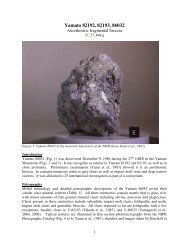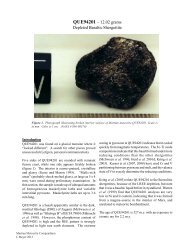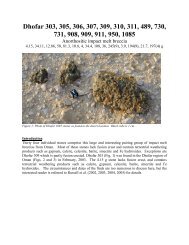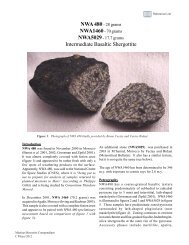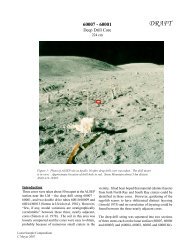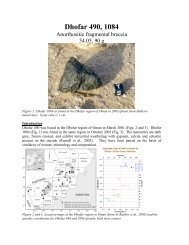Meteorites, Clues to Solar System History - NASA
Meteorites, Clues to Solar System History - NASA
Meteorites, Clues to Solar System History - NASA
- No tags were found...
Create successful ePaper yourself
Turn your PDF publications into a flip-book with our unique Google optimized e-Paper software.
6of accomplish a goal can be established. Each path is defined as a specific subset oftasks that must be performed and each subset of tasks is identified by a sequentialnumber. For example, in order <strong>to</strong> satisfy the goal Game-Goal 1, we can complete theobliga<strong>to</strong>ry tasks V1 and V2, or V1 and V3. For Game-Goal 2, both V3 and V4 areobliga<strong>to</strong>ry. Optionally, players can carry out the third one. The intersection of thesubsets of tasks cannot be empty, so an obliga<strong>to</strong>rily / optionally symbol can be labeledwith several numbers separated by colons.Finally, another aspect related <strong>to</strong> the Tasks and Goals Model is the set of <strong>to</strong>ols thatcan be utilized <strong>to</strong> perform the tasks. Basically, a player, while executes a task, canneed two kinds of <strong>to</strong>ols: collaborative <strong>to</strong>ols (chat, forum, discussion room, groups<strong>to</strong>ck, etc.) and game <strong>to</strong>ols (a map of the virtual world, a key, a notebook, etc.). Eachtask has associated a set of <strong>to</strong>ols, so it is possible <strong>to</strong> detect if the players have used allthe available <strong>to</strong>ols. In negative case, the teacher can promote the use of certain <strong>to</strong>ol inthe next games (for example, the discussion room makes that the students clarify theirquestions more easily, and in addition allows them <strong>to</strong> reach a consensus and extendthe learned concepts).In order <strong>to</strong> assign goals and tasks properly, we have define two attributes for eachgoal: experience and difficulty. In this model, experience indicates the minimum levelof experience that a player should have <strong>to</strong> face this goal and difficulty suggests theinitial difficulty level recommended <strong>to</strong> this goal. Similarly, tasks have attributes forexperience and difficulty: Experience indicates the recommended level of experiencefor this task and difficulty informs about the optimal level for this task. A goal shouldhave tasks with different level of experience and difficulty in order <strong>to</strong> allow the teacher<strong>to</strong> assign tasks according <strong>to</strong> the students’ needs.These two attributes can be updated during the game based on parameters as:− A student needs <strong>to</strong> repeat a task− A student is bored before he achieves secondary or not many interesting goals.− Experience acquired by a student in other tasks or in previous games− How far a student is <strong>to</strong> achieve a particular goal.State of the Game ModelThe State of the Game Model s<strong>to</strong>res information about the current game. We distinguishtwo parts in this model: individual players’ area and group’s area (Fig. 2). Thismodel is destroyed when the game finishes, therefore, it is a short-term model [7]which temporal life is limited <strong>to</strong> the duration of each the game.Fig 2. State of the Game Model
Meteorite curation. This is the meteoritecuration facility at <strong>NASA</strong>‘s Johnson SpaceCenter in Hous<strong>to</strong>n, Texas. It is operated bythe same group which curates the Apollolunar samples. A companion facility is atthe Smithsonian National Museum ofNatural His<strong>to</strong>ry in Washing<strong>to</strong>n, DC.MicrometeoritesThe smallest objects approaching Earth are cosmic spherulesand interplanetary dust particles (IDP). They are calledmicrometeorites because they are so small that a microscope isneeded <strong>to</strong> see them. Because micrometeorites are small andhave very large surface areas compared <strong>to</strong> their masses, theyradiate heat rapidly and are not melted as they pass through theatmosphere. Cosmic spherules are droplets less than a millimeterin size that are found in deep sea sediments and Antarctic andGreenland ice. EUROMET has an active micrometeoritecollection program with a curation facility in Orsay, France.IDPs are micrometer-sized irregular aggregates that vary widelyin composition, mineralogy and structure. <strong>NASA</strong> collects IDP’sin the upper atmosphere using military airplanes with collec<strong>to</strong>rsattached under their wings. The collec<strong>to</strong>rs are opened uponreaching high altitudes and closed before returning <strong>to</strong> the ground.This ensures that only high altitude particles are collected. Someof these particles are man-made space debris, others are ashfrom Earth’s volcanoes, but many are interplanetary dust. TheseIDP’s are curated at <strong>NASA</strong> Johnson Space Center in a labadjacent <strong>to</strong> the Antarctic meteorite curation lab. <strong>NASA</strong> cura<strong>to</strong>rsdescribe, announce and distribute the IDP’s which are studied byscientists around the world.Cosmic dust collection. <strong>NASA</strong> collectscosmic dust in collec<strong>to</strong>rs mounted onaircraft that fly in the stra<strong>to</strong>sphere.Interplanetary dust particle. This fluffyaggregate of grains was collected by <strong>NASA</strong>high in the atmosphere. It consists of avariety of minerals loosely held <strong>to</strong>gether. Itis sitting on a metal surface with holes in it.<strong>NASA</strong> EG-1997-08-104-HQTeacher’s Guide 7
Crater cross sections. This diagram shows two views of a typical impact crater. The left view shows the circularcrater with its rim and scattered ejecta. The right view shows that the rim is above and the crater floor is below theoriginal surface. The ejecta are thickest closest <strong>to</strong> the rim.crater diameter. These numbers vary with the speed, size, mass, and angle of approach of the impactingobject, and with the nature of the target rocks.Finding a circular crater is not sufficient <strong>to</strong> identify it as an impact crater because there are also volcaniccraters. Although their size ranges overlap, impact craters tend <strong>to</strong> be larger than volcanic craters. Theirstructures also differ. A volcanic crater’s floor is often above the surrounding surface, while an impactcrater’s floor is below the surrounding terrain. Thus a fresh impact crater is circular, with a raised rim and alowered floor. Impact craters are also surrounded by rocky material thrown from the crater, ejecta. Thebest proof of an impact crater is associated meteorite fragments; after that, the next best indica<strong>to</strong>r is thenature of its rocks. They are broken, dis<strong>to</strong>rted or even melted by the shock of the explosive impact. Muchof the ejecta outside the crater is broken pieces of various rocks mixed <strong>to</strong>gether <strong>to</strong> form a breccia. Therocks inside the crater are also breccias which are highly shocked and sometimes melted. The originalbedrock below the crater is shocked and fractured. (See Lessons 6 and 7)Catastrophic ImpactsLooking at the surface of the Moon we see craters ranging in sizefrom tiny <strong>to</strong> gigantic. The largest basins are the dark, roughlycircular mare that are filled with solidified basalt. Such largeimpacts must have had a major affect on the whole Moon.Studies of lunar rocks returned by the Apollo missions showedthat the giant impacts happened about 3.9 billion years ago (seecompanion volume Exploring the Moon). Studies also showedthat the breccias formed by impact on the Moon are rich in somemetals that are abundant in meteorites, but rare in rocks on thesurfaces of the Moon and Earth. Iridium is one such metal that iscommon in meteorites. Its discovery in the K/T boundary soiloffers an explanation of a catastrophic Earth event.Aristarchus. The lunar crater Aristarchusis about 40 km in diameter. It is one of themost studied craters on the Moon.The K/T boundary is the layer of soil that marks the end of the Cretaceous (K) period and beginning of theTertiary (T) period of geologic time. It occurred 65 million years ago when three-fourths of all species oflife on Earth became extinct. Other time boundaries in earlier periods also mark extinctions of manyspecies. Geologists have tried <strong>to</strong> understand the causes of these mass extinctions, suggesting perhaps<strong>NASA</strong> EG-1997-08-104-HQTeacher’s Guide 9
major changes in climate. In 1980 geologists discovered that this layer is surprisingly rich in iridium. Theysuggested that the iridium was from a giant meteorite that impacted the Earth throwing a tremendous volumeof dust in<strong>to</strong> the atmosphere. While the immediate effects of the impact would have been regional, the effec<strong>to</strong>f the dust in the atmosphere could have been global. The climate might have been changed drastically forsome time after the impact. For years the impact hypothesis seemed plausible, but there were no terrestrialcraters with the right age and size <strong>to</strong> have caused these changes. Recently, geologists found a 65 millionyear old buried crater that is over 200 km across on the Yucatan Peninsula in Mexico. It, possibly incombination with other craters the same age, might be the “smoking gun” of the K/T mass extinctions (seeLesson 14).The Tunguska Impact. In 1908 the biggestmeteor in recorded his<strong>to</strong>ry shot across theTunguska River in Russia and exploded.(Credit: Smithsonian Institution)It is only natural <strong>to</strong> ask when the last large impact occurred on Earthand whether another one could occur soon. Meteor Crater wasmade by the impact of a large meteorite 50,000 years ago.Although it is a relatively small crater, it would have caused majordestruction in a city, had there been any in existence at the time.Two medium-sized impacts occurred this century in Russia,Tunguska in 1908 and Sikhote-Alin in 1947 (see Lesson 15). TheTunguska explosion was large enough <strong>to</strong> have caused significantdestruction if it had happened near a city.The threat of global devastation froma major impact led the U.S. governmentand <strong>NASA</strong> <strong>to</strong> propose theSpaceguard Survey. It would havebeen an international network of au<strong>to</strong>mated telescopes that would scan the sky in search ofall Earth-approaching asteroids or comets large enough (1 km) <strong>to</strong> cause severe destruction.Once their orbits were determined, calculations would be done <strong>to</strong> predict whether any body wouldimpact Earth. Although the full international program was not approved, there are at least twosmaller programs which search the sky for incoming asteroids and comets. A means of deflectingthe asteroid or comet out of its orbit would then be needed <strong>to</strong> avoid a catastrophe. Although theprobability of a devastating impact is very low, the potential destruction of such an impact is sogreat that precautions are warranted.The impact of Comet Shoemaker-Levy 9 onJupiter in July 1994 was the first timescientists predicted the impact of a smallbody on a planet. The comet was discoveredin March 1993 after it broke apart in<strong>to</strong>22 fragments as it passed close <strong>to</strong> Jupiter.The orbit of this “string of pearls” wasdetermined by continued telescopicobservation. Calculations predicted that onits next pass through Jupiter’s orbit thefragments would impact the planet.Because of the predictions, thewhole world watched andwaited, while thousands of10 Teacher’s Guide<strong>NASA</strong> EG-1997-08-104-HQ
Comet Shoemaker-Levy 9 approachingJupiter. This picture is a composite ofpho<strong>to</strong>graphs taken by the Hubble SpaceTelescope. The “string of pearls” is thebroken pieces of comet Shoemaker-Levy 9which were pho<strong>to</strong>graphed during theapproach <strong>to</strong> Jupiter. The collisions in July1994 were the first predicted impacts of anasteroid or comet on a planet. (Credit:Space Telescope Science Institute.)telescopes were aimed at Jupiter as the fragments of the comet impacted the planet on schedule. The views fromthe Hubble Space Telescope and from the Galileo spacecraft were even better than from large Earth-basedtelescopes. The successful identification of the comet and prediction of its impact allude <strong>to</strong> the potential capabilitiesof the Spaceguard Survey.Meteorite Classificationand FormationClassification<strong>Meteorites</strong> are rocks that are made upof a variety of minerals. Minerals arenaturally occurring crystalline materialscomposed of elements in definedproportions and structures. The mostcommon minerals in meteorites arelisted in the Meteorite ABC’s FactSheet on page 29. Most meteoriteminerals are similar <strong>to</strong> those occurringin Earth rocks, but a few of the rarerminerals are found only in meteorites.Different types of meteorites havedifferent types and proportions ofminerals and different compositions.Therefore, meteorites are classified bytheir mineralogy and composition. AsMeteorite Sample Disk. The meteoritesample disk contains six different meteoritesamples. See page iv for more informationon using this disk in the classroom.<strong>NASA</strong> EG-1997-08-104-HQTeacher’s Guide 11
ALH90411 chondrite. This s<strong>to</strong>ny meteoriteis chondrite A in the meteorite sample diskand accompanying lithographs. This sawnsurface shows an irregular texture withround chondrules, broken fragments, and alittle dark rusted metal. ALH90411 is a lowiron chondrite and is not metamorphic.LEW87030 chondrite. This s<strong>to</strong>ny meteoriteis chondrite B in the meteorite sample disk.It has a more uniform texture thanALH90411 and indistinct chondrules(vertical streaks are saw marks). It also haslots of shiny metal. LEW87030, likeNoblesville, is a high iron,metamorphic chondrite.discussed in the section on identifying meteorites, the simplest classification of meteorites in<strong>to</strong> s<strong>to</strong>ny, iron,and s<strong>to</strong>ny-iron types is based on the amount of iron metal and silicate minerals in the meteorite. It isrelatively easy <strong>to</strong> tell whether a sample has little metal, is mostly metal, or is about half metal and half silicateminerals. This can be determined by looking at the amount of metal and silicate minerals in the sample’sinterior and by hefting it <strong>to</strong> feel its density because iron metal is about twice as dense as silicate minerals.Each of the three major types of meteorites shows considerable variability and is further subdivided basedon mineralogy and composition. Meteorite classification is complex because of the diverse possibilities.<strong>Meteorites</strong> represent many different rock types and probably come from different bodies in the solarsystem. However, after detailed studies, some meteorites of different types appear <strong>to</strong> be related <strong>to</strong> eachother and possibly come from the same solar system body. A simplified listing of meteorite types is given inthe Meteorite ABC’s Fact Sheet.S<strong>to</strong>ny meteorites are divided in<strong>to</strong> chondrites and achondrites based on whether they contain smallround balls of silicate minerals called chondrules. Chondrites contain chondrules and achondrites do not.Chondrites are the most abundant type of meteorites, making up nearly 90% of both falls and Antarcticmeteorites. Chondrites are divided in<strong>to</strong> several classes, including ordinary chondrites, the most common,and carbonaceous chondrites, perhaps the most interesting because of their potential <strong>to</strong> tell the earliesthis<strong>to</strong>ry of the solar system.12 Teacher’s Guide<strong>NASA</strong> EG-1997-08-104-HQ
ALH84028 carbonaceous chondrite. Thiss<strong>to</strong>ny meteorite has a highly irregulartexture with distinct round chondrules,white inclusions, and little metal in a darkcarbon-bearing matrix (vertical streaks aresaw marks). It is a carbonaceous chondritesimilar <strong>to</strong> Allende, the carbonaceouschondrite in the meteorite sample disk.RKPA80224 basaltic achondrite. Thiss<strong>to</strong>ny meteorite contains no chondrules ormetal and is an achondrite. Basalticachondrites consist of feldspar (whitemineral) and pyroxene (dark mineral) andare similar <strong>to</strong> basalts that formed from lavason Earth and the Moon. This sample has anigneous texture showing that it crystallizedfrom a melt. Other basaltic achondriteshave the same mineralogy and composition,but are breccias containing broken rockfragments. The achondrite in the meteoritesample disk, EET83227, is a basalticachondrite breccia.Ordinary chondrites consist of variable amounts of metal and chondrules in a matrix of mostly silicateminerals. The silicates are mostly olivine and pyroxene, with minor feldspar. Further subdivisions ofordinary chondrites are based on the amount of iron metal and the variability in composition and texture.Some are high iron chondrites, others are low or very low iron types. Chondrites which have distinctchondrules and variable mineral compositions have not been heated since they formed and are non-metamorphicchondrites. Metamorphic chondrites have indistinct chondrules and constant mineral compositionsand have been changed since their initial formation.Carbonaceous chondrites are a very special meteorite class because they are the most primitive meteoritesand they contain water and carbon compounds. These chondrites consist mostly of the silicate mineralsolivine and pyroxene or clay minerals that formed from them by weathering. Carbonaceous chondritescontain very little metal, but contain unusual inclusions, and 2-20% water in their clay minerals. The carbonoccurs in elemental form as graphite and occasionally diamond, and in organic molecules which rangefrom simple molecules <strong>to</strong> amino acids, the building blocks of DNA and life. Carbonaceous chondritesshow variations in composition and degree of metamorphism and weathering.Achondrites are the second most abundant type of meteorites (8%) and many are similar <strong>to</strong> igneous rockson Earth. Achondrites are divided in<strong>to</strong> several classes, of which the most abundant is basaltic achondrites,and the most unusual is planetary meteorites. The basaltic achondrites are actually a family of threedistinct subclasses that are grouped <strong>to</strong>gether because they appear <strong>to</strong> be related <strong>to</strong> each other. The mostcommon are pyroxene-feldspar igneous rocks similar <strong>to</strong> basalts on Earth. Many of these basalts werebroken up by impacts so that the meteorites are breccias made up of basalt fragments. Another typeconsists mostly of pyroxene and may have formed by accumulation of minerals sinking in a magma. The<strong>NASA</strong> EG-1997-08-104-HQTeacher’s Guide 13
Gibeon iron meteorite. This pho<strong>to</strong> shows asawed surface which has been etched withacid <strong>to</strong> reveal the criss-cross Widmanstattenpattern. The Gibeon iron meteorite in thesample disk and the Sikhote-Alin meteoritehave fine intergrowths of iron-nickel metals.Brenham s<strong>to</strong>ny-iron meteorite. This s<strong>to</strong>nyironmeteorite consists of yellow-greenolivine crystals surrounded by iron-nickelmetal. It is a cumulate s<strong>to</strong>ny-iron and isused in the meteorite sample disk.third type are complex breccias made up of fragments of the other two types. These meteorites formed byimpact mixing on the surface of a parent body.Planetary meteorites are a recently recognized class of achondrites which include both lunar and martianmeteorites. They are igneous rocks and breccias that formed from igneous rocks. Their compositions andmineral proportions range widely. Some are basalts that crystallized as lavas. Others are cumulates, rocksthat formed by accumulation of minerals floating or sinking in magmas. These include lunar anorthositebreccias which formed by feldspar floating (see companion volume Exploring the Moon) or martiancumulates which formed by pyroxene and olivine sinking. More lunar and martian meteorites have beenfound in Antarctica than in the rest of the world.Iron meteorites, which make up only 5% of meteorite falls, consist almost entirely of iron-nickel metal withvariable amounts of sulfides and occasional inclusions of silicate minerals. Iron meteorites usually consist oftwo distinct iron-nickel minerals, kamacite (high iron) and taenite (high nickel) which are intergrown <strong>to</strong> forma criss-cross Widmanstatten pattern which can be seen when the sample is etched lightly with acid. Ironsare subdivided both by the texture of this intergrowth and by the composition of trace elements in the metal.However, the textural and compositional subdivisions do not correlate well. Some groups of iron meteoritesmay be related <strong>to</strong> basaltic achondrites.14 Teacher’s Guide<strong>NASA</strong> EG-1997-08-104-HQ
S<strong>to</strong>ny-irons, which are the least abundant major type of meteorites (1%), include both cumulate andbreccia varieties. The cumulates consist of metal and the silicate mineral olivine, where the olivine grains arelarge and surrounded by metal grains. The metal and silicates formed by slow cooling of heavy phases froma melted body. The metal and silicate grains in the s<strong>to</strong>ny-iron breccias are usually much smaller than in thecumulates, and the texture is a complex mixture of broken fragments imbedded in matrix. The silicatefragments are similar <strong>to</strong> those in basaltic achondrites. Both cumulate and breccia s<strong>to</strong>ny-irons may comefrom the same bodies as basaltic achondrites.Meteorite ResearchMany different types of science are involved in the study of meteorites, their formation and their sources.Meteorite research bridges the gap between geology, the study of Earth’s rocks and landforms, andastronomy, the study of the Sun, planets, moons, and stars in space. Planetary geology is a new sciencewhich began when we were first able <strong>to</strong> study the Moon and other planets up close. Planetary scientistsstudy the planets and other bodies in the solar system using pho<strong>to</strong>graphs and chemical or physical datacollected from flyby and orbiting spacecraft or robotic landers: Voyager, a flyby craft, explored the outerplanets; the orbiter Magellan focused on Venus; Viking studied Mars with both orbiters and robotic landers.The Apollo missions <strong>to</strong> the Moon provided the only chance so far for humans <strong>to</strong> walk on another planetarybody, <strong>to</strong> study the landforms, and <strong>to</strong> bring rocks back <strong>to</strong> Earth for detailed analyses (see companion volumeExploring the Moon).Meteoriticists are scientists who study meteorites. They may be trained in geology, chemistry, physics, orastronomy because all these fields are needed <strong>to</strong> understand meteorites and their relationships <strong>to</strong> bodies inthe solar system. Meteoriticists often work in teams so that specialists in several different fields contribute <strong>to</strong>the research. Mineralogists study the mineralogy and textures of thin slices of rock; chemists analyze rocksfor their elemental and iso<strong>to</strong>pic compositions and determine ages; physicists measure physical propertiessuch as magnetism.To learn about the relationship of meteorites <strong>to</strong> planetary bodies, astronomers try <strong>to</strong> match meteorites withpossible sources. Planetary geologists study impact craters on Earth, the Moon and planets <strong>to</strong> understand theimpact process. Other scientists do notstudy meteorites or planetary bodiesdirectly, but do experiments in labora<strong>to</strong>ries<strong>to</strong> simulate the processes of meteoriteformation or impact. <strong>NASA</strong> funds mos<strong>to</strong>f the research on meteorites that is donein the U.S. through grants <strong>to</strong> investiga<strong>to</strong>rsat universities, industry, and governmentlabora<strong>to</strong>ries.Meteorite research. This scientist isworking at a scanning electron microscope.With this instrument the scientist can lookin detail at the mineralogy, composition,and physical structure of meteorites.<strong>NASA</strong> EG-1997-08-104-HQTeacher’s Guide 15
Processes of meteorite formation. Thisdiagram illustrates several meteoriteformation processes. The first processes arecondensation from a gas <strong>to</strong> a solid (notillustrated) followed by accretion of smallparticles <strong>to</strong> form an asteroid or planet.When the accreted body is heated, it ismodified by metamorphism or differentiation.Even if heating is not enough <strong>to</strong> meltthe body, it may undergo metamorphicprocesses which make the texture andmineral compositions more uniform. Ifheating melts the body, it may undergodifferentiation: Metal separates from thesilicate melt and sinks under the influenceof gravity <strong>to</strong> form the core. Silicateminerals crystallize and heavy minerals,like olivine and pyroxene, sink <strong>to</strong> form themantle, while light ones, like feldspar andsome pyroxene, float <strong>to</strong> form the crust.Volcanism (not illustrated) brings basalts<strong>to</strong> the surface <strong>to</strong> add <strong>to</strong> the crust. Weathering(not illustrated) alters the surface rocksthrough chemical or physical changes.Finally, impacts on a variety of bodiesbreak off fragments that may fall <strong>to</strong> Earthas meteorites.Formation ProcessesThe processes of meteorite formation have been identified by comparing studies of meteorite mineralogy,composition and ages with those of Earth and Moon rocks, and experimental results. On Earth, rocks formby igneous, metamorphic and sedimentary processes, but the continued action of these processes haserased all evidence of Earth’s initial formation. <strong>Meteorites</strong> bear evidence of the his<strong>to</strong>ry of the solar systemfrom its initial formation <strong>to</strong> recent volcanism and impacts on Mars. Chondrites are primitive objects formedat the beginning of the solar system and changed by metamorphic and sedimentary processes. Achondrites,irons, and s<strong>to</strong>ny-irons are differentiated objects formed by igneous processes and changed by impacts andmetamorphism. Evidence for these processes is listed on the <strong>Solar</strong> <strong>System</strong> ABC’s Fact Sheet on page 31.Many of the details of the processes are not fully unders<strong>to</strong>od — hence meteorite research continues — butenough is known <strong>to</strong> present a general s<strong>to</strong>ry of meteorite formation.The evidence for the primitive nature of chondrites is found in their ancient ages, Sun-like compositions, andunusual minerals and textures. All chondrites are 4.5-4.6 billion years old. They are the oldest rocks in thesolar system and are used <strong>to</strong> date the beginning of the solar system. Chondrite compositions are verysimilar <strong>to</strong> that of the condensable part of the Sun without the gaseous elements, H and He. Carbonaceouschondrites are most similar <strong>to</strong> the Sun’s composition because they contain volatile components such aswater and carbon compounds. Chondrites tell us about formation of solid bodies from the cloud of gas anddust called the solar nebula. Carbonaceous chondrites contain stardust and white inclusions. Stardust iscomposed of minerals such as diamond and silicon carbide which are thought <strong>to</strong> have formed in a red giantstar before our Sun was formed. The white inclusions consist of unusual minerals which were the firstminerals <strong>to</strong> condense from a gas in the formation of the solar system. This condensation is the first stage insolar system formation. The gases in the solar nebula gradually condense as it cools <strong>to</strong> produce the minerals16 Teacher’s Guide<strong>NASA</strong> EG-1997-08-104-HQ
found in meteorites, first the white inclusions, then silicate minerals. Chondrules are melted and crystallizedspheres of silicate minerals which are thought <strong>to</strong> have formed by flashheating as the solid matter in the solar system condensed.Accretion is the physical process of building up chondritesand planetary bodies by collecting <strong>to</strong>gether smaller pieces ofunrelated materials such as chondrules, white inclusions,stardust, and volatile components. The variations in chondritemineralogy and composition show that there were areas in theearly solar system with different compositions or temperatureand pressure conditions. Inverse variations in the amount ofiron in metal versus iron in silicate minerals suggest thatthere were variations in oxidation state for different chondritetypes. Variations in volatile contents suggest that the volatilerichcarbonaceous chondrites accreted at lower temperaturesthan volatile-poor ordinary chondrites. (See Lesson 10)The organic compounds in carbonaceous chondrites are believed <strong>to</strong>have formed very early in solar system his<strong>to</strong>ry. There is considerable varietyin organic compounds in carbonaceous chondrites, from simple molecules <strong>to</strong> amino acids, butapparently none were formed by living organisms. The evidence for this is in the symmetry of the organiccompounds which are found in both right- and left-handed forms in meteorites, while similar compoundsformed by living organisms on Earth are found only in one form. (See Lesson 12)After condensation and accretion, most chondrites were changed by metamorphism and weathering. Heatingof originally heterogeneous chondrites <strong>to</strong> temperatures below their melting points caused the mineral compositions<strong>to</strong> homogenize and chondrules <strong>to</strong> fade in<strong>to</strong> the matrix. Heating of carbonaceous chondrites allowed their water <strong>to</strong>weather the olivine and pyroxene silicates <strong>to</strong> clay minerals. This was the first weathering in the solar system, anEarth-like sedimentary process that <strong>to</strong>ok place near the beginning of the solar system.Differentiated meteorites (achondrites, irons, s<strong>to</strong>ny-irons) have compositions very different from those ofthe chondrites or the condensable part of the Sun. However, if their compositions are recombined in therelative proportions in which they fall <strong>to</strong> Earth, the average differentiated meteorite composition is a lotcloser <strong>to</strong> chondrite composition. Most differentiated meteorites are also ancient rocks 4.4-4.5 billion yearsold, nearly as old as the primitive chondrites. The only exceptions are planetary meteorites which have agesranging from 180 million years through 4.5 billion years. Although many differentiated meteorites arebreccias broken and mixed by impacts, it is apparent that most are rocks that originally crystallized frommelts and formed by igneous processes.The suite of differentiated meteorites is evidence of early differentiation on asteroids (and planets) in<strong>to</strong> core,mantle and crust. Heating of the body <strong>to</strong> above the melting temperature allowed separation of iron and silicatemelts and later separation of crystallized minerals. Iron meteorites represent the core of the asteroid whichformed by slow cooling from an iron melt <strong>to</strong> produce the intergrown iron-nickel minerals. S<strong>to</strong>ny-iron cumulatescome from the core-mantle boundary where iron melt surrounded olivine silicate minerals. Basaltic achondritesare mostly from the crust of the asteroid, with cumulates possibly from the upper part of the mantle. Basalticachondrites flowed as lava on<strong>to</strong> the surface, just like basaltic lavas produced by volcanism on the Earth, Moon,and Mars. Finally, breccias of basaltic achondrites and s<strong>to</strong>ny-irons represent the soil and rocks at the surface ofan asteroid where various rock types are broken and mixed by impacts. (See Lesson 11)<strong>NASA</strong> EG-1997-08-104-HQTeacher’s Guide 17
Meteorite Sources<strong>Meteorites</strong> fromAsteroids<strong>Meteorites</strong> are “rocks from space,” butthere’s a vast area of space out there.Our Sun is just one of billions of stars inthe Milky Way galaxy, which is one ofbillions of galaxies in the universe. Luckily,we don’t have <strong>to</strong> search all of outerspace for the sources of meteoritesbecause scientists think that meteoritescome from our own “backyard,” from theasteroids, comets, moons and planets inour solar system (see <strong>Solar</strong> <strong>System</strong>ABC’s Fact Sheet).Asteroid Ida. This pho<strong>to</strong>graph of 52 km asteroid 243 Ida was taken in1993 by the Galileo mission. The asteroid is a rocky body that isirregular in shape and covered with impact craters.Most meteorites appear <strong>to</strong> come from asteroids, the small (diameter less than 1000 km) rocky bodies tha<strong>to</strong>rbit the Sun in the region between Mars and Jupiter, but are mostly concentrated in the asteroid beltbetween 2.2-3.2 AU (astronomical unit, the mean distance between the Earth and Sun). The evidence thatmost meteorites come from asteroids is based on comparison of meteorite and asteroid orbits andmineralogies. Three meteorites have been observed pho<strong>to</strong>graphically as they approached Earth. It waspossible <strong>to</strong> calculate the orbits of the Innisfree, Lost City, and Pribram meteorites from a series of timedpho<strong>to</strong>graphs. These are all elliptical orbits that extend from Earth back <strong>to</strong> the asteroid belt. (See Lesson 4)Asteroids are so small and far away that telescopes on Earth see them only as points of light. Astronomers findasteroids by studying telescopic images and looking for the objects that move compared <strong>to</strong> the stationary starfield. Long exposure pho<strong>to</strong>graphs show a background of stars as bright spots with a streak of light from anasteroid caused by its movement across the sky. To calculate the orbit of an asteroid, one must measure itsposition at several different places and times, but it is not necessary <strong>to</strong> follow it through an entire orbit. Asteroidalorbits are ellipses rather than circles (see Lesson 4), but most orbits are not <strong>to</strong>o far from circular and thereforestay within the asteroid belt and do not cross the orbits of the planets. A few asteroids, such as Aten, Apollo, andAmor, have highly elliptical orbits that cross the orbits of Earth or Mars, while others like Hec<strong>to</strong>r are in the orbitsof Jupiter or beyond. Gravitational interactions with Jupiter, and impacts between asteroids in the belt may breakthem up and send the resulting fragments in<strong>to</strong> planet-crossing orbits.Ceres, the largest asteroid (almost 1,000 km) was the first asteroid found in 1801. Since then over 6,000asteroids have been catalogued. Most asteroids are very small, only three are larger than 500 km, and onlyabout 25 are larger than 250 km. All of the Earth- and Mars-crossing asteroids are smaller than 30 km.Our first close up look at asteroids was provided by the Galileo spacecraft that flew by and pho<strong>to</strong>graphedasteroids Gaspra in 1991 and Ida in 1993. Both are irregular masses of rock, seemingly broken andcovered with impact craters. Phobos and Deimos, the moons of Mars, look very much like asteroids in sizeand shape. The next planned asteroid encounters are part of the NEAR mission. It will fly by asteroidMathilde in summer 1997 and orbit and map asteroid Eros in 1999. The <strong>Solar</strong> <strong>System</strong> ABC’s Fact Sheetgives information for twenty asteroids in order of distance from the Sun. It gives examples from each of thegroups of planet-crossers and several of the larger asteroids that populate the asteroid belt.18 Teacher’s Guide<strong>NASA</strong> EG-1997-08-104-HQ
Meteorite and asteroid orbits. Orbits ofmeteorites and asteroids compared <strong>to</strong> thoseof Earth, Mars and Jupiter. (Top) The orbitsof three meteorites, Innisfree, Lost City andPribram, were calculated from series oftimed pho<strong>to</strong>graphs taken as each meteoritefell <strong>to</strong> Earth. (Bot<strong>to</strong>m) Orbits of sevenasteroids are shown. The three closest <strong>to</strong>the sun, Aten, Apollo and Amor, are ellipticaland cross the orbits of Earth or Mars.The next three, Vesta, Ceres and Hygeia, arein the asteroid belt where most asteroids arefound. The last one, Hec<strong>to</strong>r, is in Jupiter’sorbit, but spaced far enough from the planetthat it does not impact Jupiter.Astronomers study different types of asteroids using the brightness and color of light they reflect. This iscalled reflectance spectroscopy. Asteroids are divided in<strong>to</strong> several classes (indicated by letters) basedon their overall brightness and reflectance spectrum. E asteroids are very bright, S and M asteroids aremoderately bright, and C and D asteroids are dark. U asteroids are unusual and varied. E, M, and Uasteroids are rare, while S and C asteroids are common. The asteroid belt appears <strong>to</strong> be zoned, with mos<strong>to</strong>f the S asteroids in the inner part of the belt, C asteroids in the central <strong>to</strong> outer belt, and D asteroids only inthe outer belt. (See Lesson 5)The spectrum of reflected light at different wavelengths is caused by the mineralogy on the surface of theasteroid. If we have reflectance measurements of appropriate mineral and rock standards, we can determinethe mineralogy of an asteroid by matching it <strong>to</strong> that of the standards. In this way we find that E asteroidsare rich in iron-free pyroxene, M asteroids are rich in metal, C and D asteroids are rich in carbon, Sasteroids are mixtures of metal and silicates, and Vesta, one of the U asteroids, is made of basaltic rock.When compared <strong>to</strong> meteorites, fairly good matches between asteroid and meteorite classes are found. Easteroids match a special class of achondrites, M asteroids match irons and s<strong>to</strong>ny-irons, Vesta matchesbasaltic achondrites, C and D asteroids match carbonaceous chondrites. However, S asteroids are not avery good match for ordinary chondrites. Also, there is a problem that the most abundant type of asteroidin the inner asteroid belt does not match the most common type of meteorites. Our knowledge of the<strong>NASA</strong> EG-1997-08-104-HQTeacher’s Guide 19
elationships between asteroids and meteorites is still incomplete. Nevertheless, there is a general relationshipbetween meteorites and asteroids, and a zoning in asteroid types in the asteroid belt This suggests thatasteroids represent the transition in formation from rocky inner planets <strong>to</strong> volatile-rich, outer planets.<strong>Meteorites</strong> from CometsComets are small (1-10 km) balls of ice and dust that spend most of their time in the frigid outer solarsystem, but make spectacular displays when their highly elliptical orbits bring them in<strong>to</strong> the warmer innersolar system. The Sun’s heat produces a gaseous coma around the solid nucleus and long tails of gas anddust that can be seen by the naked eye. Periodic comets, like Halley which appears every 76 years, haveelliptical orbits centered near Jupiter and Saturn and periods of less than 200 years. Most comets have verylong periods (>10,000 y) and have visited the inner solar system only once in recorded his<strong>to</strong>ry. They havenearly parabolic orbits and spend most of their time in the Oort cloud far beyond the orbit of Plu<strong>to</strong>. CometsHyakutake and Hale-Bopp that visited the inner solar system in 1996-97 have periods of 65,000 years and4,200 years, respectively.Comets are considered <strong>to</strong> be the most primitive bodies in the solar system. They are “dirty snowballs”consisting of water, methane and ammonia ices mixed with silicates and a little metal dust. They are thought<strong>to</strong> have formed in the region around Uranus and Neptune, but were moved <strong>to</strong> new orbits by gravitationalinteraction with the planets: Periodic comets we see <strong>to</strong>day were moved inward <strong>to</strong>ward Jupiter and Saturn.Most comets, however, were thrown outward beyond the planets <strong>to</strong> form the Oort cloud.Comets are clearly related <strong>to</strong> periodic meteor showers. Almost all periodic showers occur when Earthcrosses the orbit of a periodic comet. Meteors are produced as cometary particles of dust and gas areburned up in the Earth’s atmosphere. The <strong>Solar</strong> <strong>System</strong> ABC’s Fact Sheet lists several comets and theirassociated meteor showers. The relationship between comets and meteorites is less certain. Since thecompositions of comets and interplanetary dust particles are quite similar, comets are thought <strong>to</strong> be thesources of IDP’s. Comet composition is also somewhat similar <strong>to</strong> that of some carbonaceous chondrites; arelationship with them is possible, although much less certain. Until we have more detailed information onthe nature and composition of comets, either from robotic landers or comet sample return missions such asthe Stardust mission <strong>to</strong> comet Wild 2, we will not know with certainty whether comets are the sources ofcarbonaceous chondrites.Comet Halley. This pho<strong>to</strong>graph of CometHalley and a meteor, which appears as astreak, was taken on January 7, 1986 at theMount Palomar Observa<strong>to</strong>ry. The inset isan image of the nucleus of Comet Halleytaken by the European Space Agency’sGiot<strong>to</strong> spacecraft shortly before closestapproach.20 Teacher’s Guide<strong>NASA</strong> EG-1997-08-104-HQ
<strong>Meteorites</strong> from the Moon and MarsThe surfaces of the Moon and the rocky inner planets showmany craters caused by meteorite impact. Could some of theseimpacts have ejected material in<strong>to</strong> space that might later fall <strong>to</strong>Earth as meteorites? Before the Apollo lunar landings a fewscientists thought that meteorites might come from the Moon.But none of the lunar rocks returned by six Apollo missions in1969-1972 resembled meteorites. It was ten years later whenthe first lunar meteorite, ALHA81005, was identified in Antarctica.Although not identical <strong>to</strong> any specific Apollo sample, thisachondrite is an anorthosite breccia that is very similar <strong>to</strong> manysamples collected in the lunar highlands (see companionvolume Exploring the Moon). Since 1982, a <strong>to</strong>tal of fifteenlunar meteorites have been identified. These meteorites includeanorthosite breccias from the highlands and basalts and brecciasfrom the lunar mare.The identification of martian meteorites is a space detective s<strong>to</strong>ry.Because we have not yet returned samples from Mars we have<strong>to</strong> rely on what we learned from robotic exploration and ourMoon. This pho<strong>to</strong>graph of the Moon wastaken during the Apollo 17 mission. Thelight areas are highlands that are coveredmainly with breccias rich in anorthosites.The dark areas are maria that are coveredwith basalt lavas.understanding of rocks from the Earth, Moon and asteroids. In 1976 the Viking mission provided our firstdetailed look at Mars using two orbiters which pho<strong>to</strong>graphed the whole surface and two landers whichanalyzed the atmosphere and soil.The intensive studies of lunar samples and meteorites in the 1970s led <strong>to</strong> general models for planetarydifferentiation and evolution. Small bodies like asteroids differentiated early, if at all, and their heat enginesdied shortly after solar system formation. Hence asteroidal meteorites, including basaltic achondrites, areclose <strong>to</strong> 4.5 billion years old. Larger bodies like the Moon and planets stayed active longer and haveLunar meteorite ALHA81005. This 31 g(ping pong ball-sized) meteorite is abreccia rich in light colored anorthositefragments melted and mixed <strong>to</strong>gether byimpacts in the lunar highlands. Other lunarmeteorites are dark colored basalts from themare. The scale is 1 cm across.<strong>NASA</strong> EG-1997-08-104-HQTeacher’s Guide 21
younger rocks on their surfaces, such as lunar basalts which are3-4 billion years old. The Earth is obviously still producingigneous rocks <strong>to</strong>day.Mars. This picture of Mars is a compositemade from many pho<strong>to</strong>s taken during theViking mission. The crack across the middleis a canyon as long as the United States.The dark circles at the left are hugevolcanoes that are the largest in the solarsystem.When geochemists discovered the SNC family, a group ofachondrites which were 1.3 billion years old or less, they arguedthat they must be from a body larger than the Moon, perhapsMars. The absence of lunar meteorites was used <strong>to</strong> argue that itwas not possible <strong>to</strong> get meteorites off the surfaces of planets.The argument was if you couldn’t get meteorites from the Moonwith its lower gravity and closer distance, you couldn’t get themfrom Mars. The discovery of first one, and then several, lunarmeteorites refuted that argument. The definitive clues <strong>to</strong> amartian origin were found by comparing the meteorites <strong>to</strong> theViking lander measurements. The martian soil had the compositionof weathered basaltic rocks similar <strong>to</strong> the basaltic SNCmeteorites. But the real clincher was the discovery that gases inone meteorite, EETA79001, had compositions identical <strong>to</strong> thoseViking measured in the martian atmosphere. The rock actuallyhad martian atmosphere trapped inside. In all there are twelvemartian meteorites and all of them are igneous rocks, eitherbasalts or olivine and/or pyroxene cumulates.Martian meteorite EETA79001. Remainsof dark fusion crust, created during highspeed entry through Earth’s atmosphere arevisible.Martian meteorite EETA79001. This 8 kg (soccer ball-sized) meteoriteis a basalt similar <strong>to</strong>, but distinct from, basalts on Earth, the Moon, andthe basaltic achondrite asteroid. It has dark glass-lined holes whichcontain gases with compositions the same as those measured in themartian atmosphere by the Viking lander.22 Teacher’s Guide<strong>NASA</strong> EG-1997-08-104-HQ
Brief His<strong>to</strong>ry of the <strong>Solar</strong> <strong>System</strong>Our geological understanding of the his<strong>to</strong>ry of the solarsystem has been pieced <strong>to</strong>gether by geologists andastronomers based on numerous studies of the largebodies and rocks in the solar system. Many differentscientists participated in the study of the Earth, Sun, Moon,planets, asteroids, and comets. Some studied the astronomicalbodies with telescopes; others did geology withorbital data and pho<strong>to</strong>graphs; and still others studied themineralogy, composition, and ages of Earth and Moonrocks and meteorites. These studies haverevealed a series of processes in solar systemhis<strong>to</strong>ry: condensation, accretion, differentiation,volcanism, metamorphism, weathering, and impact.These processes have taken place throughout the rocky inner solar system, but the duration and extent ofthe last four processes depend on the solar system body. Therefore, different bodies and their rocksprovide evidence for different processes in solar system his<strong>to</strong>ry. This evidence is tabulated in the <strong>Solar</strong><strong>System</strong> ABC’s Fact Sheet, page 31.The Earth, Moon and Mars have no evidence remaining of initial planet formation by condensation andaccretion. Primitive chondrite meteorites provide the evidence for the beginning of solar system his<strong>to</strong>ry.Iron, s<strong>to</strong>ny-iron meteorites, lunar anorthosites, and seismic studies of Earth’s interior structure provideevidence of early differentiation in<strong>to</strong> core, mantle, and crust. Basalts are products of volcanism on all typesof rocky bodies. Changes in the original mineralogy and composition of rocks were produced by metamorphism,weathering and impact on various bodies <strong>to</strong> different degrees.Dating these events can be done in both relative and absolute ways. Relativedating on Earth is done in layers of rock where the rock on the bot<strong>to</strong>m ispresumed <strong>to</strong> be older than the rock on the <strong>to</strong>p (unless there is evidence thatthe whole unit is turned over). However, when comparing meteorites orrocks from various planets these relationships are not available so absolutedating must be used. Absolute dating of rocks is based on radioactive decayof some elements with very long half-lives. The process that is dated dependson whether the rock was changed by later processes and how extensive thosechanges were. For example, if we want <strong>to</strong> date the initial formation of a meteorite(accretion of a chondrite or crystallization of a basaltic achondrite) the sample should be one that has notbeen extensively changed by metamorphism or weathering.A solar system timeline based on dating of many meteorites and rocks from both Earth and Moon is given inthe <strong>Solar</strong> <strong>System</strong> ABC’s Fact Sheet. Like layers in rocks on Earth, the youngest events are at the <strong>to</strong>p, theoldest are at the bot<strong>to</strong>m. Although scientists don’t fully understand all of these formation processes, they doknow generally what happened and when. Some of these processes <strong>to</strong>ok place at about the same time ondifferent bodies in the solar system. Some processes <strong>to</strong>ok place once and were finished. Sun and planetformation and initial differentiation are good examples of this. Other processes such as volcanism, metamorphism,and weathering continued over different periods of time on different bodies.<strong>NASA</strong> EG-1997-08-104-HQTeacher’s Guide 23
Billions of years ago, the elements which would eventually make up our solar system were produced inother stars. Around 4.6 billion years ago a rotating disk of gas and dust called the nebula formed from theseelements. The center of the nebula collapsed under gravity <strong>to</strong> form the Sun. Slightly later, about 4.55 billionyears ago, continued condensation and accretion led <strong>to</strong> the formation of the planets, moons and asteroids ofthe solar system. Very soon after their formation the inner planets, Moon and some of the larger asteroidsmelted and differentiated <strong>to</strong> produce core-mantle-crust. Basaltic volcanism, metamorphism and weathering<strong>to</strong>ok place shortly after the surfaces of these bodies formed. Thereafter the asteroids were geologicallyinactive except for impacts and the evidence of their early his<strong>to</strong>ry was preserved.The Moon and inner planets continued <strong>to</strong> evolve geologically for various periods of time which appear <strong>to</strong>depend on the size of the body. The record of their earliest geologic his<strong>to</strong>ry is obscured by this subsequentactivity. The oldest Moon rocks, anorthosites, norites and troc<strong>to</strong>lites, date the initial differentiation and firstmagmas production at 4.4-4.5 and 4.2-4.5 billion years, respectively. The lunar cataclysmic bombardment(discussed in the companion volume Exploring the Moon) occurred about 3.9 billion years ago. Marebasaltic volcanism began before 4 billion years and continued until around 2-3 billion years. Geologicactivity (other than impact) on the Moon ended long ago.Our knowledge of the geologic his<strong>to</strong>ries of Mars and Venus is extremely limited. The Viking mission <strong>to</strong> Marsrevealed ancient highlands, giant “young” volcanoes, and extensive surface weathering. The samples analyzed bythe Viking lander were weathered rocks and soils. The martian meteorites are all igneous rocks most of whichhave ages of 180 million years (My) <strong>to</strong> 1.3 billion years. Thus martian basaltic volcanism continued at least <strong>to</strong> 180My ago. One martian meteorite is an ancient rock 4.5 billion years old. The Magellan mission remote observationssuggest that there may still be active volcanoes on Venus <strong>to</strong>day. We have only very limited analyses ofsurface samples and no known meteorites from Venus so our information about the geologic his<strong>to</strong>ry of Venus iswoefully inadequate.Earth is clearly the planet about which we have the most information. However, Earth’s current geologic processes(plate tec<strong>to</strong>nics, volcanism, metamorphism and weathering) have hidden the early his<strong>to</strong>ry by changing thesurface rocks. The earliest known Earth rocks are about 4.0 billion years old, although geologists think that Earthhis<strong>to</strong>ry began at 4.5 billion years along with the Moon and asteroids. Earth is clearly still geologically active <strong>to</strong>day.Earth is the only body in the solar system where we know for certain that life began and evolved. Theconditions necessary for life as we know it (water, carbon, nitrogen and moderate temperature) are notcurrently available on any other body; however, there is evidence that Mars was wetter and may have beenwarmer in the past. The ancient martian meteorite may containevidence of fossil life from an earlier era. The debate about life inthe martian meteorite continues and may not be resolved withoutmartian returned samples. The earliest evidence of life on Earthis dated around 3.7 billion years ago. Life evolved through upsand downs <strong>to</strong> the present. Periodic mass extinctions changed thedirection of evolution. For example, at 65 million years ago75% of all species died and small mammals <strong>to</strong>ok over dominancefrom the giant reptiles called dinosaurs. Whether theMartian meteorite ALH84001. This 4.5billion year old rock may contain fossilevidence that primitive life may haveexisted on Mars as much as 3.6 billionyears ago.cause of these mass extinctions is a biologic process or thegeologic process of meteorite impact is still hotly debated.Nevertheless, meteorite impacts, both small and medium-sized,continue on Earth and other planets at the present.24 Teacher’s Guide<strong>NASA</strong> EG-1997-08-104-HQ
The his<strong>to</strong>ry of our solar system is long and complex. Our knowledge has been gained through various studies ingeology and astronomy and related fields. Scientists are still trying <strong>to</strong> understand the physical and chemicalprocesses in solar system his<strong>to</strong>ry so the s<strong>to</strong>ry is not complete. However, the his<strong>to</strong>ry as we see it involves similarprocesses occurring at varied times on different bodies. Taken as a whole, it is a fascinating s<strong>to</strong>ry.Future ExplorationFurther understanding of the his<strong>to</strong>ry of the solar system is closelylinked <strong>to</strong> the future exploration of space by robotic and humanmissions. There is still much that we can learn about solar systemprocesses from studies of meteorites and Apollo lunar samplesand from telescopic studies of the planets. But think how muchmore we can learn about planetary bodies with new samples andclose-up geologic exploration! The six Apollo lunar landingsdemonstrated the value of human observation and ingenuity inexploration and returned many documented samples for continuedstudies. The spectacular results of the Voyager and VikingNear Earth Asteroid Rendezvouz (NEAR)spacecraft. The NEAR mission willrendezvouz with Asteroid 433 Eros inFebruary 1999.missions showed how much we can learn about distant planets from robotic missions. Future missions suchas the Mars Surveyor orbiter and lander series and the Discovery class missions <strong>to</strong> the Moon (Prospec<strong>to</strong>r),an asteroid (NEAR) and a comet (Stardust) promise exciting discoveries in the next ten years.Exploration of space has other benefits besides knowledge. It creates new technologies and, perhaps moreimportantly, it inspires people <strong>to</strong> excel and <strong>to</strong> work <strong>to</strong>gether. However, space exploration, especially humanexploration, is a very expensive business. Not only must the benefits of knowledge, technology, inspiration,and cooperation be high, but the costs must be reduced as much as possible. One of the most effectivemeans of reducing costs comes from using space resources and reusing everything possible.Asteroidal Resources<strong>NASA</strong> has worked on a number of plans for future robotic exploration of the planets, asteroids, and cometsand on human missions <strong>to</strong> the Moon and Mars. The most important expendables for space exploration areenergy for transportation and operations and consumables for life support. It takes lots of expensive energy<strong>to</strong> move a mass of consumables against Earth’s gravity. It takes much less energy <strong>to</strong> move the same mass inlower gravity environments like the Moon and especially asteroids. There is a big advantage in energy, andMining an Asteroid. This is an artist’s ideaof mining an asteroid <strong>to</strong> support spaceexploration. Depending on the type ofasteroid, the products might be oxygen,metal, glass, water, organic compounds orseveral of these resources at once. (Credit:Dennis Davidson)<strong>NASA</strong> EG-1997-08-104-HQTeacher’s Guide 25
thereby cost, in using space resources as compared <strong>to</strong> carrying them from Earth. It may even be advantageous<strong>to</strong> get resources from one place in space for use in other places.The closest planetary targets, the Moon, Mars, and asteroids, have little or no atmosphere and surfacewater, and no known plants for food, but there is abundant energy for operations from solar radiation.Moreover, the rocks and soils can provide many of the elements necessary for space exploration. Therocks themselves are nearly half oxygen, and some also contain water and organic compounds. <strong>NASA</strong> hasdeveloped technologies <strong>to</strong> extract oxygen from rocks, producing metals or glass as by-products. Thisoxygen will be used mostly for spacecraft propulsion, but also for astronaut life support. The metals andglass, as well as surface rocks and soil, can be used for building materials and radiation shielding. <strong>NASA</strong>has also developed methods of growing plants in closed environments, reusing scarce consumables.The first targets for extended space exploration and resource utilization are likely <strong>to</strong> be the Moon andasteroids. The Moon is close and relatively easy <strong>to</strong> get <strong>to</strong>. Although it doesn’t have air, water, or food, weknow what it is like, and we could produce oxygen, water, and even food in lunar fac<strong>to</strong>ries and greenhouses.Ideas for a Moon base are discussed in the companion volume Exploring the Moon. Asteroidsare such small bodies that their minimal gravity makes it easy <strong>to</strong> get materials off the surface and in<strong>to</strong> space.In fact it takes less energy <strong>to</strong> get materials <strong>to</strong> and from some near-Earth asteroids than from the Moon. TheMoon and asteroids could provide test-beds for proving technology <strong>to</strong> sustain life on Mars or extendedspace flight.Asteroids are particularly promising for using space resources because they offer a variety of differentresources. Asteroids similar <strong>to</strong> s<strong>to</strong>ny meteorites could provide oxygen for fuel and metal or glass forconstruction. Asteroids similar <strong>to</strong> ironmeteorites could provide metal, evensome precious metals, with very littleprocessing. Perhaps most promising,asteroids similar <strong>to</strong> carbonaceouschondrites could provide water andorganic compounds essential for lifesupport. Mining asteroid resourcescould become a stepping s<strong>to</strong>ne <strong>to</strong>human exploration of the outer solarsystem. (See Lesson 17)Mars ExplorationMars is the ultimate near-term goal forhuman space exploration. It is theclosest planet that may be habitable bypeople. Venus, although closer <strong>to</strong>Earth, has a highly <strong>to</strong>xic atmosphereFuture mission <strong>to</strong> Mars. In the year 2020Mars exploration will be returning samplesfrom the red planet. (Credit: Pat Rawlings)26 Teacher’s Guide<strong>NASA</strong> EG-1997-08-104-HQ
Exploring Mars. This painting shows astronauts exploring Mars using a rover for transportation. The astronauts areat the <strong>to</strong>p cliff of a large canyon which is shrouded in mist. (Credit: Pat Rawlings)and extremely high temperatures which make it uninhabitable. Mars has a less <strong>to</strong>xic atmosphere andmoderate temperatures. Mars has always intrigued people because some astronomers thought they sawchannels suggesting the possibility of intelligent life. Recent geologic studies have shown that all surfacefeatures are natural formations, but also confirmed that Mars is the only other planet in our solar system thatcould once have harbored life of some kind. Although the Viking landers did not detect life in the martiansoil, we can’t be certain that life doesn’t or did not exist elsewhere on the planet. Mars is now cold and dry,but it was not always so. There is evidence that water flowed on the surface in the past. Mars was oncewetter and may have been warmer, and more hospitable for life. Several martian meteorites show interactionwith martian water. The oldest one, ALH84001, may even have evidence of past life on Mars. Thepossibility of life and the more habitable conditions make Mars an important target for exploration.Most of our information about Mars was collected during the Mariner and Viking missions. They wereflybys and orbiters that pho<strong>to</strong>graphed the planet and made geophysical and geochemical measurements,and landers that analyzed the atmosphere and soil composition. Mars’ weather is always changing. Windand dust s<strong>to</strong>rms are common and sometimes global. The polar ice caps change with seasonal temperaturechanges. Major changes occurred some time in the past which made the surface water disappear and theatmosphere decrease. We do not yet understand the causes of these changes.Mars’ geology is also fascinating. Although the planet is much smaller than Earth, the scale of its majorgeologic features is much larger. Mars’ volcanoes are the largest in the solar system, ten times greater thanthe largest on Earth. Mars’ huge canyon, Valles Marineris, is as long as North America is wide! Mars isdivided by a global cliff in<strong>to</strong> old cratered southern highlands and young volcanic northern plains. Both thehighlands and the plains have been eroded by water and wind. The two Viking landing sites in the plainshad soil compositions similar <strong>to</strong> basalts altered by water. The martian meteorites are all igneous rocks,mostly from the young northern plains, but they contain some minor minerals in cracks and bubbles that areproducts of alteration by water. There are many questions left unanswered about the geology and climate<strong>NASA</strong> EG-1997-08-104-HQTeacher’s Guide 27
of Mars. How has the planet changed with time? Why are the northern and southern hemispheres sodifferent? What caused the climate <strong>to</strong> change drastically so that the surface water and atmosphere disappeared?Is water or ice present at the poles or as permafrost? Is there convincing evidence of life, eitherliving organisms or fossils? These are some of the questions <strong>to</strong> be addressed by future exploration.The exploration of Mars is a complicated and expensive endeavor. The trip <strong>to</strong> Mars takes at least sixmonths when the two planets are closest, which happens every two years. Ideally, Mars exploration willinclude a combination of robotic and human missions. Robotic exploration is necessary in the early stages<strong>to</strong> conduct global surveys and investigate potential sites for human exploration. Robotic missions will alsotest technologies, deliver cargo, and return the first documented Mars samples. Human missions are desirablefor detailed exploration of selected sites because people are best at observation, interpretation andproblem solving.Preparation for a human mission <strong>to</strong> Mars is extensive. The mission would last about three years, includingthe long trip each way and plenty of time for exploration while waiting for the planets <strong>to</strong> return <strong>to</strong> closestapproach. This extended mission requires a huge amount of consumables, both for fuel and for lifesupport. The amounts can be reduced <strong>to</strong> about one third by using Mars’ resources. The selected siteshould be one where water or ice is available for human use. <strong>NASA</strong> is developing technologies <strong>to</strong> produceoxygen from the carbon dioxide in Mars’ atmosphere. This would be used for breathing, but also <strong>to</strong> powerrovers for exploration and the spacecraft for the return trip <strong>to</strong> Earth. Astronauts could grow plants for foodin greenhouses that recycle CO 2and other waste components. With habitats for shelter and rovers fortransportation, the first Mars outpost could be nearly self-sufficient. It would also be the first step in apermanent human presence on Mars.Once their basic needs are met the astronauts will spend part of their time on exploration and sampleanalysis. They will observe geologic formations, collect rocks and soils, and look for any signs of life. Inthe habitat labs they will do geochemical and biological analyses. Together with their scientific colleaguesback on Earth they will attempt <strong>to</strong> answer some of the questions about the evolution of Mars and its part inthe his<strong>to</strong>ry of the solar system. By exploring the asteroids and planets we may be able <strong>to</strong> solve some of themysteries revealed by meteorites.Mars Habitats. The joined habitats providethe crew with multiple pressurized volumesfor conducting greenhouse experiments,biological research, geochemical analysisof samples, and general crewaccomodations. (Credit: Jack Frassani<strong>to</strong>)28 Teacher’s Guide<strong>NASA</strong> EG-1997-08-104-HQ




